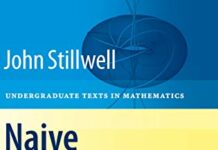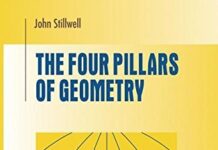
Ebook Info
- Published: 1993
- Number of pages: 348 pages
- Format: PDF
- File Size: 6.08 MB
- Authors: John Stillwell
Description
In recent years, many students have been introduced to topology in high school mathematics. Having met the Mobius band, the seven bridges of Konigsberg, Euler’s polyhedron formula, and knots, the student is led to expect that these picturesque ideas will come to full flower in university topology courses. What a disappointment “undergraduate topology” proves to be! In most institutions it is either a service course for analysts, on abstract spaces, or else an introduction to homological algebra in which the only geometric activity is the completion of commutative diagrams. Pictures are kept to a minimum, and at the end the student still does nr~ understand the simplest topological facts, such as the rcason why knots exist. In my opinion, a well-balanced introduction to topology should stress its intuitive geometric aspect, while admitting the legitimate interest that analysts and algebraists have in the subject. At any rate, this is the aim of the present book. In support of this view, I have followed the historical development where practicable, since it clearly shows the influence of geometric thought at all stages. This is not to claim that topology received its main impetus from geometric recreations like the seven bridges; rather, it resulted from the l’isualization of problems from other parts of mathematics-complex analysis (Riemann), mechanics (Poincare), and group theory (Dehn). It is these connec tions to other parts of mathematics which make topology an important as well as a beautiful subject.
User’s Reviews
Reviews from Amazon users which were colected at the time this book was published on the website:
⭐Ideas from topology are now manifested everywhere in physics, engineering, computer graphics, and many, many other applications. Consequently, a thorough understanding of topology has become necessary for those who are involved in these applications. This book gives an introduction to “classical” topology that emphasizes the geometric intuition behind the subject, and is thus very suitable for those who need such an understanding. That is not to say that aspiring mathematicians will not gain from the reading of the book. It still maintains a standard of rigor that graduate students in mathematics need to advance in more in-depth courses in topology. The author does not hesitate to use diagrams in the book, which makes it an even better one for those interested in applications. Most of the results he discusses were known in the late 1800’s and early 1900’s, but they are still important today, especially in physics. In chapter 0, the author introduces the fundamental concepts in topology with a discussion of the homoemorphism problem. Confining attention to three dimensions and less, the author does mention the impossibility of solving the problem in dimensions greater than or equal to four. He then gives an overview of open and closed sets, continuous functions, identification spaces, and elementary homotopy theory. The building blocks of the main objects he considers in the book, namely simplicial complexes, are discussed in detail. The Haupvermutung is briefly discussed, and a full proof, due to E.E. Moise, of the Jordan curve theorem is given. The proof is the first example of the general approach that the author takes in the book, namely of reducing general topology to combinatorial topology. A brief introduction to algorithms is given, and the author introduces the group theory needed for the rest of the book. Since he is taking an historical approach in this book, the author begins the study of surfaces with the study of Riemann surfaces. He motivates the ideas of Riemann surfaces, such as branched coverings of the 2-sphere, very nicely, and gives a very understandable theorem for surfaces is proved in detail. In addition, the concept of a universal covering space is described beautifully, and the author shows how to obtain it for orientable surfaces of genus greater than one. The author also gives a brief taste of Fuchsian groups. Chapter 2 is devoted completely to the group theory of graphs, as a warm up to the study of the fundamental group in the next chapter. The fundamental group is defined to be an equivalence class of maps, and with the exception of the circle, it is calculated using deformation retraction and the Seifert-Van Kampen theorem. The fundamental group of complexes are then calculated in chapter 4, using first a method due to Poincare, and then directly. Some knot theory is introduced, and the Wirtinger presentation of knot groups is discussed. Homology theory is presented in chapter 5 as an abelianization of the fundamental group, and the abelianization is shown to be independent of the presentation of the fundamental group. The author does not spend much time in homology, arguing (correctly) that in dimensions less than or equal to three the fundemental group contains all the information obtained from homology. The study of curves on surfaces is the subject of chapter 6, with the contractibility problem studied first using Dehn’s algorithm. Some methods for “simplifying” simple curves on closed orientable surfaces by homeomorphisms are also discussed. These techniques could be considered an elementary warm-up to the handle calculus procedures done in higher-dimensional topology. The physicist-string-theorist reader will appreciate the discussion of the mapping class group of the torus. All of chapter 7 is devoted to knot theory, and this subject, now of enormous importance in physics and computational biology, is treated in great detail here. The braid group is defined, and Artin’s solution of the word problem is given. A very short overview of 3-dimensional manifolds is given in chapter 8, wherein the important concept of a Heegaard splitting is discussed, along with other methods for constructing 3-manifolds. The recognition problem for the 3-sphere, and the famous Poincare conjecture, are mentioned, and the author outlines one method, called shelling a simplicial decomposition, for recoginizing a 3-sphere. He shows however the existence of an unshellable triangulation of the 3-ball (Bing’s cube). The author is incorrect though when he states that an algorithm for disproving the conjecture, i.e. an algorithm for enumerating all the 3-manifolds not homeomorphic to the 3-sphere, does not exist. Since the date of publication of this book, such an algorithm has been constructed by Rourke and Sanderson. The book ends with a discussion of unsolvable problems in combinatorial topology. This is an unusual topic in a book on topology, but given the importance currently of computer algorithms in the growing field of “computational topology” such an inclusion is appropriate and useful. The author discusses Turing machines, Church’s thesis, and the Halting problem. The author discusses the unsolvable problems in group theory, and shows how the halting problem can be reduced to the word problem in groups. He leaves as an exercise, using the formalism developed in the chapter on presentations of groups, the problem of showing the homeomorphism problem is unsolvable for closed 4-manifolds.
⭐This is a wonderfully intellectual, semi-historical approach to classical topology.Chapter 0 gets some fundamentals out of the way. Chapter 1 is very intriguing and contains lots of ideas. First we are given a taste of the Riemann surfaces of complex analysis. These are complemented by the nonorientable surfaces, and it all leads to the classification of surfaces, which is achieved through the fundamental group and the realisations of surfaces as polygons with identifications, and this in turn leads picturesquely to covering surfaces. These simply and concisely presented ideas provide the seeds for much of the later chapters. The short chapter 2 sets up the two-way connection between topology and combinatorial group theory, which proves fruitful when the fundamental group grows into two chapters of its own (3 and 4). Then follows a sort of supplementary chapter 5 which touches on homology theory (otherwise largely neglected, but with good reason, Stillwell argues) to motivate abelianisation, which is the method we use to formally tell the fundamental groups of all surfaces apart. Chapters 2-5 were a bit slowed down by foundational issues, but now in chapters 6-8 it’s all topology all the time. There are nice accounts of the classical theories of curves on surfaces (chapter 6) and knots (chapter 7). In chapter 8 we see how some of our previous ideas carry over to 3-manifolds. But ultimately 3-manifolds are deep water, with the homeomorphism problem being unsolved and all. Neither would it help to move up to 4-manifolds or higher, but at least that’s not our fault so to speak because there the homeomorphism problem is in fact unsolvable. The homeomorphism problem and other fundamental problems are essentially algorithmic (i.e., given two spaces, decide whether they are different or the same) so unsolvability (non-existence of algorithms) is indeed a force to be reckoned with, so it is given its own chapter 9, naturally culminating with the unsolvability of the homeomorphism problem.There are many ways to destroy the soul of topology. Stillwell says in the preface: “In most institutions it is either a service course for analysts, on abstract spaces, or else an introduction to homological algebra in which the only geometric activity is the completion of commutative diagrams.” Stillwell protects us from such dangers by his emphasis on low dimensions, his insistence on the fundamental group as the best unifying tool, visualisation and illustrations, and his great respect for primary sources. The latter is reflected in frequent references and in the commented, chronological bibliography, which is very useful.
⭐
Keywords
Free Download Classical Topology and Combinatorial Group Theory (Graduate Texts in Mathematics, 72) 2nd Edition in PDF format
Classical Topology and Combinatorial Group Theory (Graduate Texts in Mathematics, 72) 2nd Edition PDF Free Download
Download Classical Topology and Combinatorial Group Theory (Graduate Texts in Mathematics, 72) 2nd Edition 1993 PDF Free
Classical Topology and Combinatorial Group Theory (Graduate Texts in Mathematics, 72) 2nd Edition 1993 PDF Free Download
Download Classical Topology and Combinatorial Group Theory (Graduate Texts in Mathematics, 72) 2nd Edition PDF
Free Download Ebook Classical Topology and Combinatorial Group Theory (Graduate Texts in Mathematics, 72) 2nd Edition



